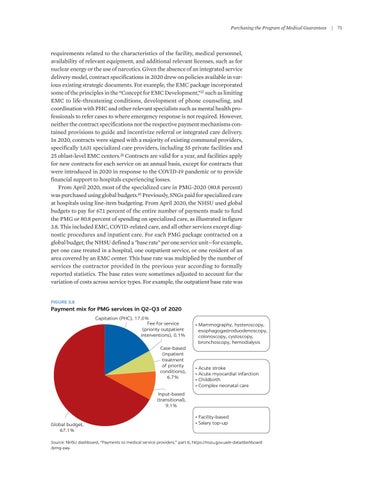Purchasing the Program of Medical Guarantees
requirements related to the characteristics of the facility, medical personnel, availability of relevant equipment, and additional relevant licenses, such as for nuclear energy or the use of narcotics. Given the absence of an integrated service delivery model, contract specifications in 2020 drew on policies available in various existing strategic documents. For example, the EMC package incorporated some of the principles in the “Concept for EMC Development,”27 such as limiting EMC to life-threatening conditions, development of phone counseling, and coordination with PHC and other relevant specialists such as mental health professionals to refer cases to where emergency response is not required. However, neither the contract specifications nor the respective payment mechanisms contained provisions to guide and incentivize referral or integrated care delivery. In 2020, contracts were signed with a majority of existing communal providers, specifically 1,631 specialized care providers, including 55 private facilities and 25 oblast-level EMC centers.28 Contracts are valid for a year, and facilities apply for new contracts for each service on an annual basis, except for contracts that were introduced in 2020 in response to the COVID-19 pandemic or to provide financial support to hospitals experiencing losses. From April 2020, most of the specialized care in PMG-2020 (80.8 percent) was purchased using global budgets.29 Previously, SNGs paid for specialized care at hospitals using line-item budgeting. From April 2020, the NHSU used global budgets to pay for 67.1 percent of the entire number of payments made to fund the PMG or 80.8 percent of spending on specialized care, as illustrated in figure 3.8. This included EMC, COVID-related care, and all other services except diagnostic procedures and inpatient care. For each PMG package contracted on a global budget, the NHSU defined a "base rate" per one service unit—for example, per one case treated in a hospital, one outpatient service, or one resident of an area covered by an EMC center. This base rate was multiplied by the number of services the contractor provided in the previous year according to formally reported statistics. The base rates were sometimes adjusted to account for the variation of costs across service types. For example, the outpatient base rate was FIGURE 3.8
Payment mix for PMG services in Q2–Q3 of 2020 Capitation (PHC), 17.0% Fee for service (priority outpatient interventions), 0.1% Case-based (inpatient treatment of priority conditions), 6.7%
• Mammography, hysteroscopy, esophagogastroduodenoscopy, colonoscopy, cystoscopy, bronchoscopy, hemodialysis
• Acute stroke • Acute myocardial infarction • Childbirth • Complex neonatal care
Input-based (transitional), 9.1%
Global budget, 67.1%
• Facility-based • Salary top-up
Source: NHSU dashboard, “Payments to medical service providers,” part 6, https://nszu.gov.ua/e-data/dashboard /pmg-pay.
|
71

